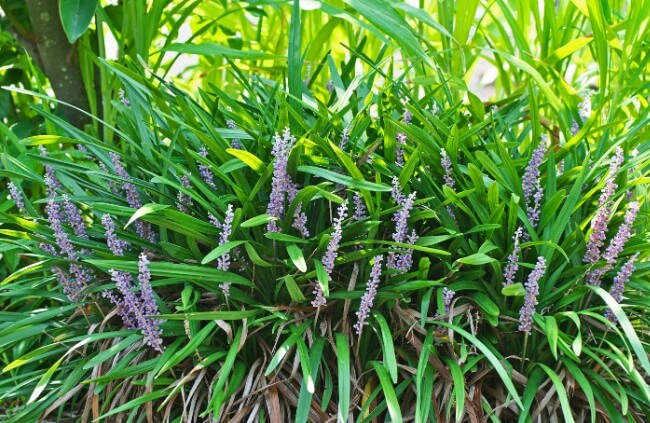Liriope is a wonderful perennial, spending most of its year as a structural grass-like plant, and transforming into stunning pillars of purple flowers in summer. Liriope ‘Evergreen Giant’ is perhaps the most dramatic of all.
If you want to spice up your borders and add texture alongside colour while maintaining seasonal interest and softening your boundaries, then get to know how to grow Liriope muscari ‘Evergreen Giant’ with this in-depth guide on planting, growing, and caring for this spectacular evergreen perennial.
More...

Family: | Asparagaceae |
|---|---|
Genus: | Liriope |
Species: | L. muscari |
Cultivar: | ‘Evergreen Giant’ |
Common Names: | Big blue lilyturf, monkey grass, border grass, lilyturf |
Origin: | China, Japan and Korea |
Location: | Outdoor |
Type: | Evergreen perennial |
Growth: | 1m x 1m |
Sun requirements: | Full sun or part shade |
Foliage Colour: | Green |
Flower Colour: | Purple |
Flowering: | Summer |
Edible Parts: | None |
Maintenance level: | Low |
Poisonous for pets: | Toxic to cats and dogs |
What is Liriope ‘Evergreen Giant’?
Liriope ‘Evergreen Giant’ is a cultivar of Liriope muscari, named for the distinct similarities in flower form and colour with muscari (the grape hyacinth).
Liriope is a small genus of just six species but with dozens of cultivars thanks to its ornamental value. The genus is identifiable as a grass-like, clump-forming perennial, some with variegations, and others without.
Liriope muscari is similar to others in its flowering habit, forming tight bulbous spikes of pinky-purple flowers on deep red stems but has fibrous, not rhizomatous, roots like other species.
This particular cultivar Liriope ‘Evergreen Giant’ was bred for height and structure, and is one of the tallest Liriope there is at 1m tall and has the ability to spread over large borders.
How Big Does Liriope ‘Evergreen Giant’ Grow?
Liriope ‘Evergreen Giant’ will grow to 1m tall, but its spread is unlimited, with each individual plant reaching a width of 1m. However, as a clump forming perennial, it can develop into 2m clumps, and with careful division and propagation will easily fill out the front of a border.
Each leaf is about 0.5m long, rippling gently in even light winds, but holding form against gusts. Flower spikes are around 1m tall, and stand proudly upright without any need for support.
Liriope muscari ‘Evergreen Giant’s Natural Habitat
In its native habitats in China, Korea and Japan, Liriope muscari enjoys cool temperate conditions around forests and woodlands, both under the shade of tree canopies, and around woodland edge sites with more exposure.
It grows on a variety of soils, as it will in gardens, from rich clays to gravel and poor soils with low nutrients. The strong but fibrous roots of Liriope muscari mean it does well on poor soils, and works particularly well as a stabiliser for controlling soil erosion.
How to Grow Liriope ‘Evergreen Giant’
Liriope ‘Evergreen Giant’ is wonderfully simple to grow, provided you’ve got enough space. It’s an incredibly unfussy plant that should be happy in most Australian gardens, but may need some extra water during the summer months.

Ideal Conditions for Planting Liriope ‘Evergreen Giant’
Soil & Drainage
As a basic rule, Liriope ‘Evergreen Giant’ doesn’t care about soil. It will grow on gravel, loam, clay or sand. However, it does need a boost to get going.
Start off by digging through plenty of organic matter in the form of organic soil improvers (manure or compost based) which will lock in moisture and support roots as they establish. The nutrient boost will help roots and top growth to develop to maturity, generally within its first year in the ground, with a wider spread the following year.
It’s worth repeating this process for any divisions of the plant in future.


Get Your Free Guide:
Master Growing Australian Natives eBook
A Must Have Complete Guide for Every Australian Garden
Get Your Free Guide:
Master Growing Australian Natives eBook
A Must Have Complete Guide for Every Australian Garden
Light Conditions & Temperature Preference
Liriope ‘Evergreen Giant’ grows just as well in full shade as it does in full sun, a trait taken from the varied native habitat of its parent, Liriope muscari.
Evergreen Giant is hardy throughout Australia, retaining its leaves all year round even in the coldest pockets of the country, and with a little more water can cope with droughts and heat waves too.
Watering Liriope ‘Evergreen Giant’
Liriope grown in shade require little to no watering after their first summer, but should be watered in well, along with additional compost when first planted. After that they can largely be left to do their own thing.
Liriope in full sun in Australia need watering throughout summer as they are evolved to cope with slightly shade, and more temperature summers. They will perform perfectly well with a generous weekly drink through summer.
How to Propagate Liriope ‘Evergreen Giant’
As with any clump forming perennial, the best method of propagation is division, but if you’ve not got the material to begin with, seed collection is simple and doesn’t cost a penny.

Propagating Liriope ‘Evergreen Giant’ from Seeds
Liriope seeds, including that of ‘Evergreen Giant’ take nearly three months to ripen, so you do need to be slightly patient if you plan on growing Liriope from seeds.
Pollination is pretty much guaranteed thanks to their towering and vibrant flower spikes, so leave flower spikes without cutting back when they finish in summer, then wait.
After a few months, the seeds, contained in green berries along the flower spike (one for each flower) will turn black. During this time, just enjoy the structure they give to the garden.
Once ripe, it’s time to sow.
- Fill a 10cm plastic pot with any reasonably well-drained compost.
- Liriope can grow in a tight space, so pop about five seeds into each pot (if they don’t all germinate, you’ll still get a decent new plant, and if they do, they’ll happily grow alongside each other).
- Water them well, and keep them in a shaded spot outdoors anywhere warm and out of direct light, where they will be watered by rainfall over winter.
- Next spring, the seeds should germinate quickly and grow into decent plants in time for summer.
Liriope ‘Evergreen Giant’ Propagation from Division
Division is the fastest and easiest way to create new Liriope ‘Evergreen Giant’ plants. Simply drive your spade into the soil and dig up a good clump of Liriope muscari. Pot it up, and you’re done.
There’s nothing special to improve your chances of success, but make sure to fill in any gaps, and add fresh compost or soil improver when planting the section you divided.
The best time to divide Liriope is in spring before they flower. If you can avoid disturbing the parent plant too much it will flower as normal this year. The new plant may flower if you’re lucky, but will usually focus on rooting in its first year.
How to Care for Liriope ‘Evergreen Giant’
Liriope grow in such a wide range of conditions that their care does depend slightly on where you live. Below, I’ve tried to break down their care based on climate and conditions, but essentially, just avoid increasing moisture in cooler conditions, and try to hold moisture in for warmer, brighter, spots.

Source: Evergreen Growers
Mulching Needs
Liriope ‘Evergreen giant’ doesn’t need mulching after it’s been planted, and is nearly always happy in the poorest of soils. However, they are used to more temperate climates than much of Australia has to offer, so it’s worth mulching around the base with wood chips in early summer to conserve moisture and reduce how often you water them.
In cooler parts of the country, or for Liriope planted in shade, avoid any mulch altogether.
Liriope ‘Evergreen Giant’ Fertiliser
There’s no real need to fertilise Liriope muscari, even on poor gravelly soils with little nutritional content. Once they have established, they can cope with rain water and minerals.
If they show signs of nutrient deficiency give them a balanced organic liquid feed, or a general-purpose slow-release feed like fish, blood and bone.
Repotting Liriope ‘Evergreen Giant’
If you grow Liriope ‘Evergreen Giant’ in a container, keep in mind that the root ball for a single plant can reach 50cm across. Containers of that sort of size should contain a full clump, but will still need repotting into fresh compost, following division, every two years.
The big benefit of that is that you can fill your garden with Liriope pretty quickly. The downside is that you might need to buy a lot of new pots, or give a lot of Liriope divisions to friends and family.
Pruning Liriope ‘Evergreen Giant’
Don’t prune Liriope unless you are trying to tidy up spent flower spikes. Other than that, Liriope ‘Evergreen Giant’ doesn’t ever need pruning.
In spring, run your fingers through the new growth to pull out any dead growth, as you would with tall grasses. This is an evergreen perennial which should stand tall and offer texture in the garden right the way through winter.
Liriope ‘Evergreen Giant’ Pests and Diseases
There aren’t many pests that trouble lily turf, but red lily beetles will eat the leaves to some extent, and scale and mealybugs seem to enjoy the protection within the crown of the plant. None really appear to do any damage.
When it comes to fungal problems, while Liriope ‘Evergreen Giant’ is resilient to them, there are many potential problems that can occur as a result of over watering, or poor drainage.
Crown Rot
Leaf and crown rot, caused by the Phytophthora palmivora fungus, can decimate lilyturf, completely destroying the centre of the plant. Thankfully, it can be fixed if it occurs in established plants.
The easiest way to fix crown rot on mature clumps of Liriope muscari is to remove the affected section and its roots entirely and bin it. If possible, dig up the rest of the clump and inspect the roots before planting into a fresh and better-drained soil mix.
Anthracnose virus
Anthracnose appears at first as yellowing leaf tips, which quickly turn brown. The affected leaves won’t recover, but by spraying them with a general-purpose organic fungicide, you can control the spread, and kill any remaining spores.
The plant will recover with new growth, provided it dries out, and the same levels of humidity don’t reoccur.
If this is a persistent problem through winter, avoid watering altogether. If it’s happening through summer, make sure water is targeted directly at the base, and avoid wetting the foliage entirely.
Root Rot
Root rot is usually the result of Fusarium or Rhizoctonia solani. On many plants, root rot is a death sentence, but if caught early enough with rhizomatous plants like Liriope, you can prevent the spread with fast and drastic action.
Root rot in rhizomatous plants is generally uneven, meaning you will notice leaves turning an even yellow colour on one side of the plant, while the rest remains fine. Dig up that side of the plant and discard it. Treat the roots around the rest of the plant with any soil fungicide, and replant it into a very gritty potting mix where it should be left to dry out.
Once dried, you can water again, building up gradually, and only when the soil dries out. After a few weeks, you should have a healthy plant again, ready to plant back in the garden.
Southern Blight
Southern blight, Sclerotinium rolfsii, attacks the base of a plant, and typically occurs during warm humid weather, or when water and soil splash up onto leaves from the ground when watering in hot weather.
Avoid southern blight with good plant hygiene, clean tools, and careful watering. If you find southern blight in your garden, there are fungicidal soil treatments available, which may be worth trying, as it can last in the soil forever without treatment.
Liriope ‘Evergreen Giant’ Frequently Asked Questions

Is Liriope ‘Evergreen Giant’ fast growing?
Liriope ‘Evergreen Giant’ is a fast growing, clump-forming perennial that can reach maturity in 2-3 years with very little ongoing maintenance.
What does Liriope muscari ‘Evergreen Giant’ look like in winter?
Liriope muscari ‘Evergreen Giant’ is, as the name suggests, evergreen, holding its leaves firmly through winter, and replacing them with fresh green growth in spring. If you leave flower spikes in place they will develop from bright purple flowers, into green seed pods, followed by deep black berries that fall in late autumn or winter.
Can you cut back Liriope ‘Evergreen Giant’?
Liriope ‘Evergreen Giant’ shouldn’t be cut back, let it develop naturally into clumps. When those clumps begin to hollow in the centre, simply divide them and replace the growth. You will run a much lower risk of fungal problems over winter if you avoid pruning or cutting back any Liriope.
Can you divide Liriope ‘Evergreen Giant’ in the summer?
The best time to divide Liriope ‘Evergreen Giant’ is in spring, but you can get away with early summer division if necessary. The effects of later divisions are reduced flowering that year, but it’s more about luck than skill.
What is the flowering period for Liriope ‘Evergreen Giant’?
Liriope ‘Evergreen Giant’ can flower as early as late spring, and as late as mid-autumn, with a lengthy flowering season to make sure your garden is in bloom for as long as possible through summer.
Wrapping Up Our Guide to Growing Liriope ‘Evergreen Giant’ in Australia
Forget common names like lilyturf or monkey turf, and think of Liriope ‘Evergreen giant’ as an ornamental in its own right. This gorgeous plant doesn’t need to be treated like grass, and it certainly doesn’t need that same level of attention.
Whatever your soil type, you can grow Liriope ‘Evergreen Giant’ in your own garden, and make excellent use of space that shines right through the year, either adding texture, colour, or height to the front of borders depending on the month.
Published on October 2, 2023 by Lorri Hopkins
Last Updated on September 20, 2025




